Microsoft Office 365 Monitoring
Know What's Happening in Microsoft 365 – With Privacy By Design
Track and maximize productivity, protect against insider risks, and maintain compliance across your Microsoft Office 365 environment. Join 10,000+ companies already building high-performing, trust-based teams with Teramind.
The Future of Workplace Monitoring
Balance productivity insights with business objectives through user behavioral analytics and intelligent monitoring. While Microsoft Office 365 provides essential monitoring capabilities, organizations can enhance their security posture by adding advanced insider risk detection, productivity analytics, and compliance controls with Teramind.
Comprehensive Activity Tracking
Monitor activities in Microsoft 365 applications with advanced behavioral analytics.
- Behavioral analytics: Detect potential threats and adapt to changing work habits using machine learning and pattern recognition
- Real-time insights: Get insights by tracking document access and collaboration patterns through actionable dashboards that highlight key metrics
- Policy enforcement: Deploy role-based security policies that automatically adjust to user behavior and department needs
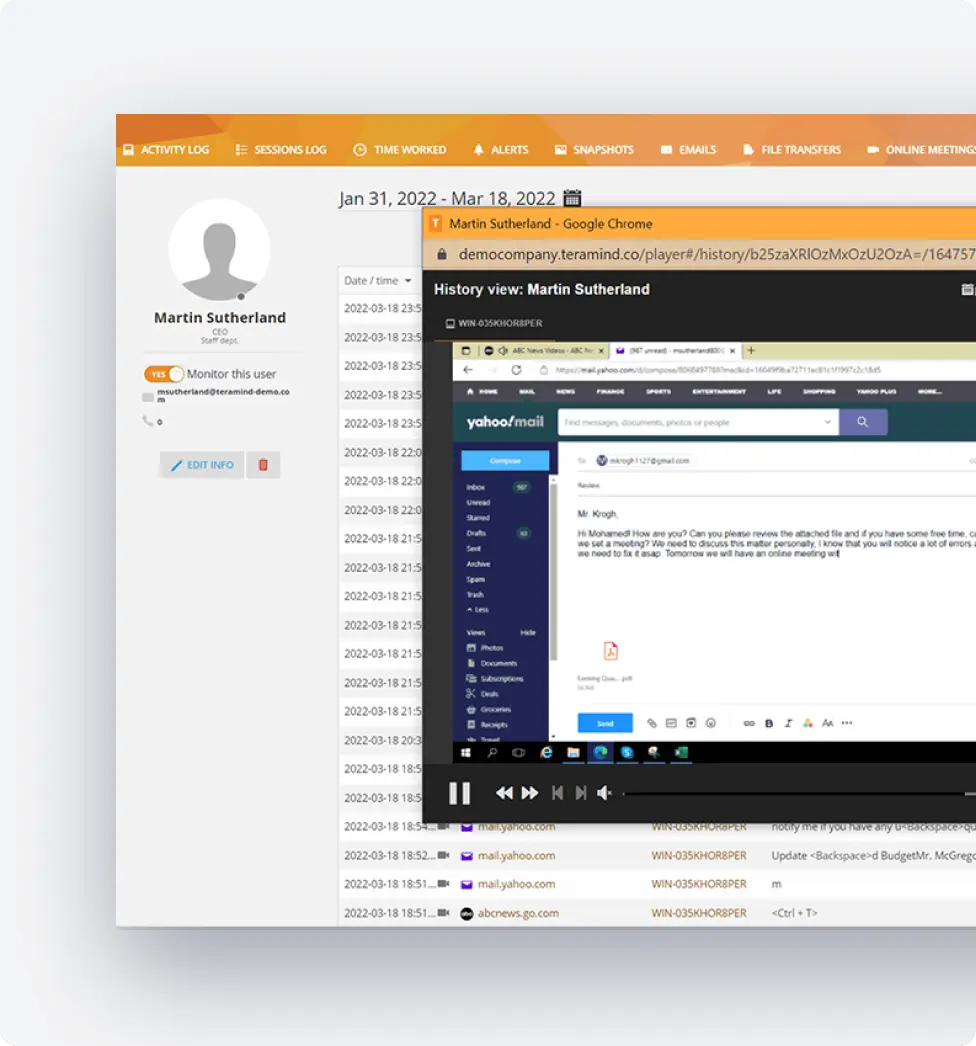
Smart Security Controls
Protect sensitive data while enabling productive collaboration.
- Data loss prevention: Behavioral DLP system that learns from user patterns and adjusts sensitivity levels automatically
- Access management: Role-based permission controls that maintain workflow efficiency across all applications
- Risk detection: Early warning system combining behavioral analysis and machine learning to identify threats
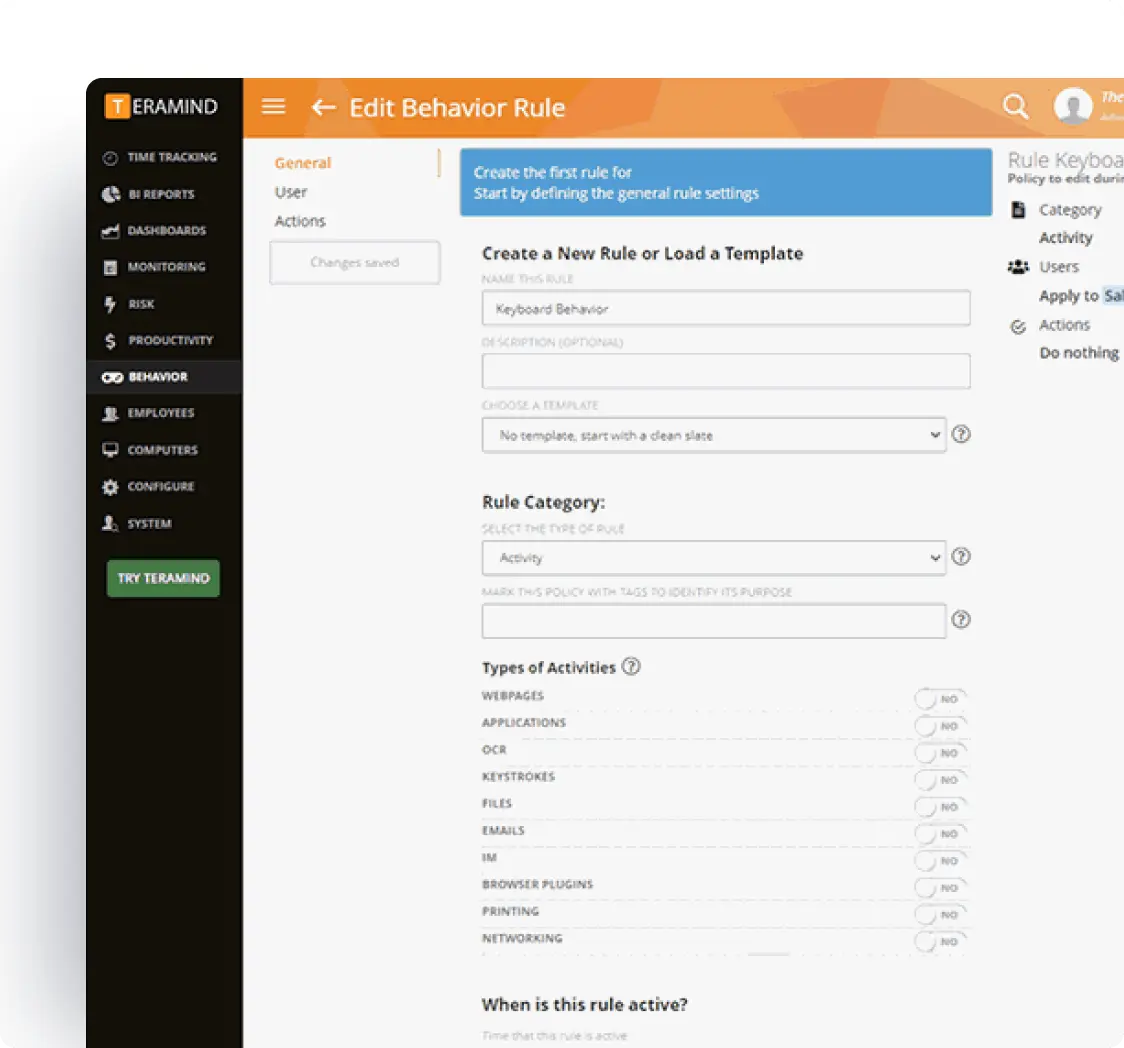
Microsoft Teams Communication Oversight
Monitor Microsoft Teams usage to enhance collaboration and security.
- Channel analytics: Track team engagement and collaboration patterns to improve communication effectiveness
- Meeting insights: Analyze participation and engagement metrics to optimize virtual collaboration
- Collaboration tracking: Monitor cross-team interactions to identify successful patterns and bottlenecks
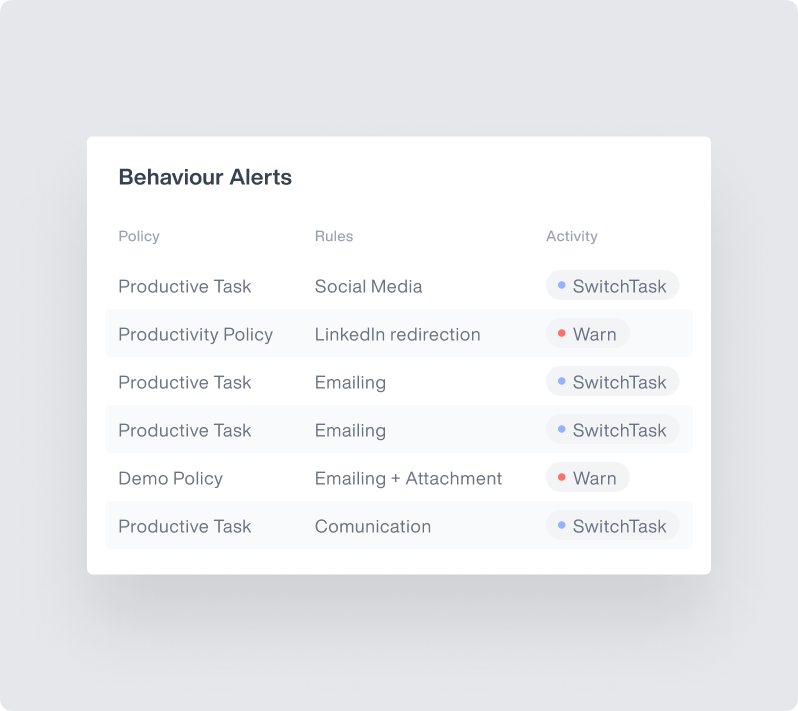
Outlook & Exchange Email Monitoring
Secure email communications with intelligent monitoring, including Exchange Online.
- Content analysis: Identify sensitive information and potential data leaks using pattern recognition
- Flow monitoring: Detect unusual patterns and communication bottlenecks across your organization
- Attachment security: Monitor file sharing behavior and enforce compliance with security policies
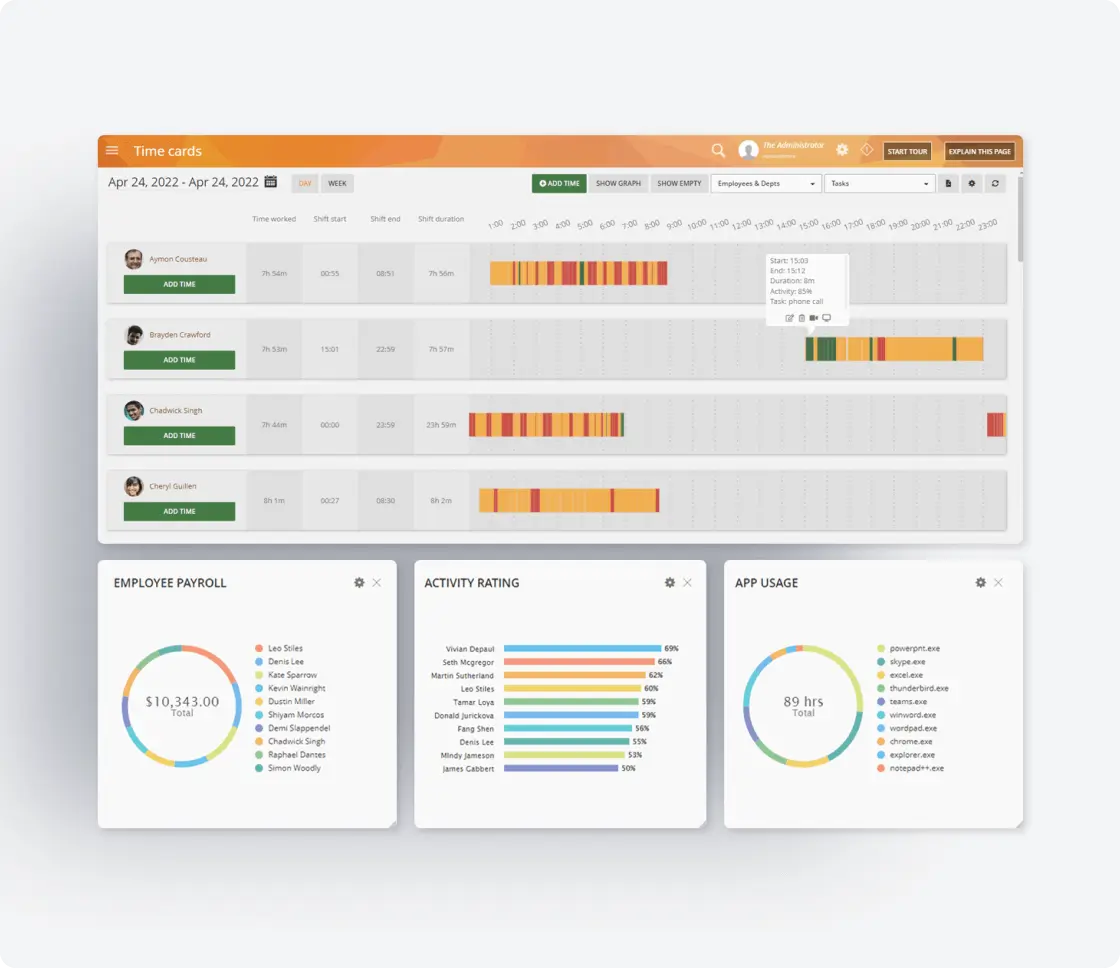
Application Usage Analytics
Understand how teams use Microsoft 365 applications.
- Usage patterns: Analyze application activity to optimize processes and identify training needs
- Productivity metrics: Measure application effectiveness and identify workflow optimization opportunities
- Resource optimization: Track resource allocation to maximize Microsoft 365 investment returns
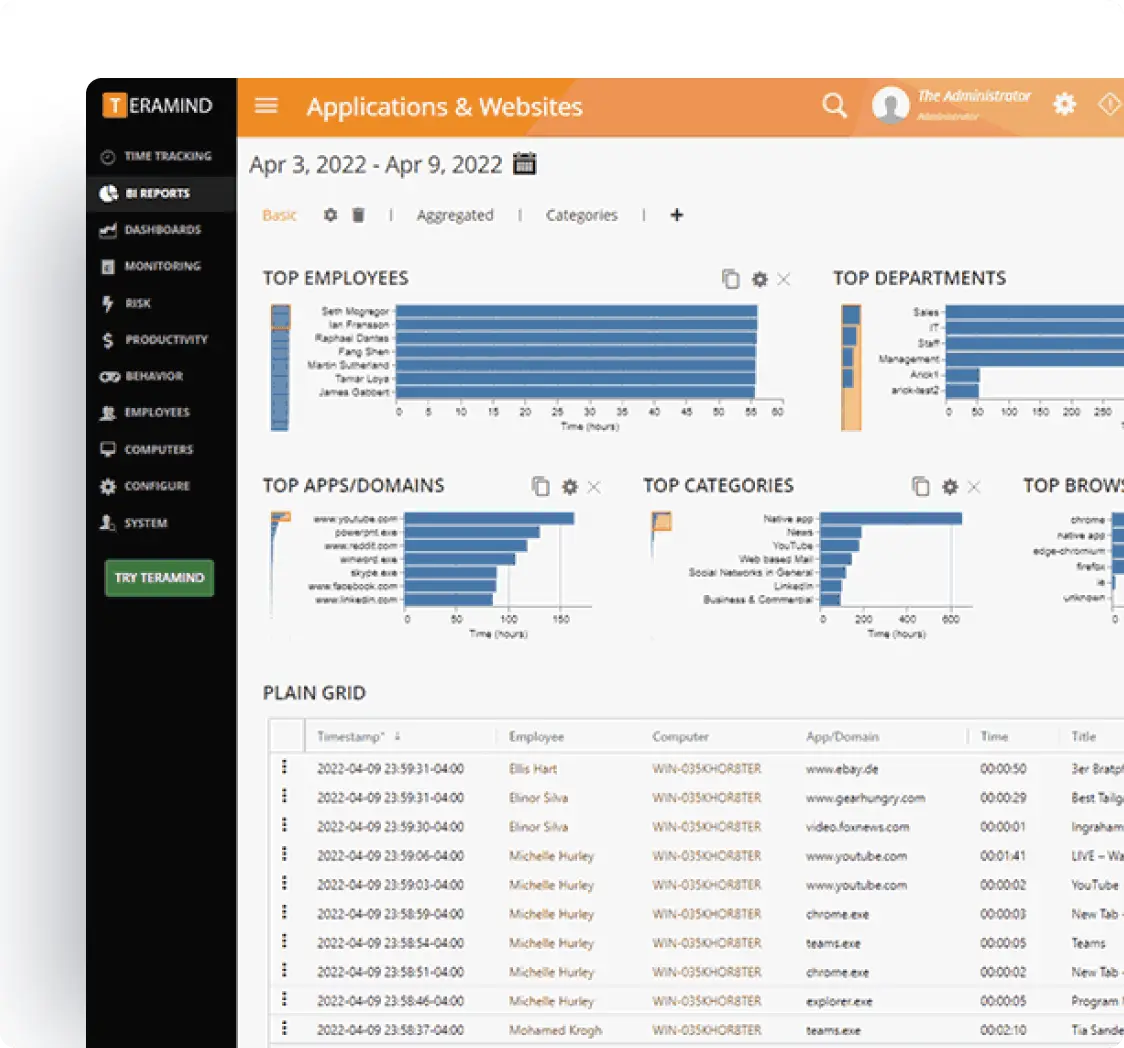
Behavioral Analytics
Leverage AI and machine learning (ML) to understand normal vs. suspicious behavior.
- Pattern recognition: Establish baseline behaviors and identify security risks using machine learning and performance monitoring
- Anomaly detection: Flag unusual activities with contextual alerts based on historical patterns
- Risk assessment: Evaluate threats by combining behavioral indicators with security metrics
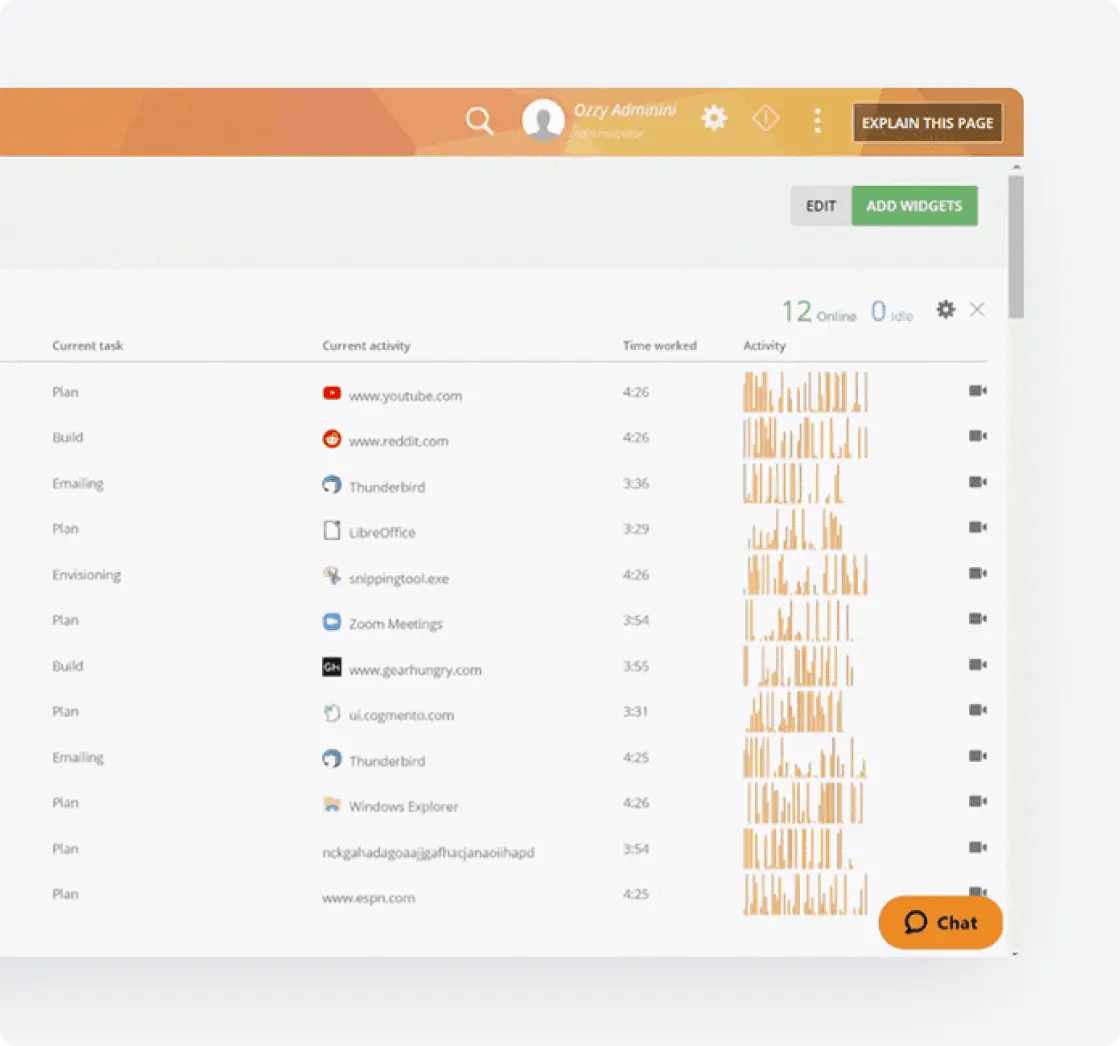
Core Teramind Features
Leverage Teramind’s unparalleled power to solve your workforce challenges.
Live View & Historical Playback
Monitor employee screens in real-time or review past activity with historical playback to gain complete visibility into user activity and computer activity.
Optical Character Recognition
Teramind’s OCR functionality allows you to extract text from images and screenshots, enhancing your monitoring and analysis capabilities.
Website
Monitoring
Track employee time spent on websites, identify unproductive web browsing, and enforce company policies with comprehensive website monitoring.
Application
Monitoring
Monitor application usage, track time spent on specific apps, and identify potential security risks with detailed application monitoring on your endpoints.
Email
Monitoring
Monitor employee emails to prevent data leaks, ensure compliance with company policies, and protect sensitive information.
Instant Message Monitoring
Track instant messages and conversations to gain insights into team communication and collaboration, and ensure compliance.
Social Media Monitoring
Monitor social media activity to protect your brand reputation, prevent data leaks, and ensure employees adhere to company policies.
Network
Monitoring
Gain visibility into network activity, identify potential security threats, and optimize network performance with network monitoring.
Citrix
Monitoring
Monitor employee activity within Citrix environments, track application usage, and ensure data security with specialized Citrix monitoring on your devices.
Remote Desktop Control
Take control of remote employee computers in real-time to provide support, troubleshoot issues, or prevent data breaches and insider threats.
RDP Session Recording
Record RDP sessions to gain a comprehensive understanding of user activity, troubleshoot technical problems, and ensure compliance.
Productivity
Analysis
Analyze employee productivity with detailed metrics, identify areas for improvement, and boost productivity across your team members.
Active Vs. Idle
Time Logs
Track active and idle time to understand how employees spend their work hours and optimize time management and productivity.
Unproductive Work
Time Analysis
Identify unproductive work time, analyze patterns, and implement strategies to improve efficiency and time management.
Try Platform
With a Live Demo
to see how it works.
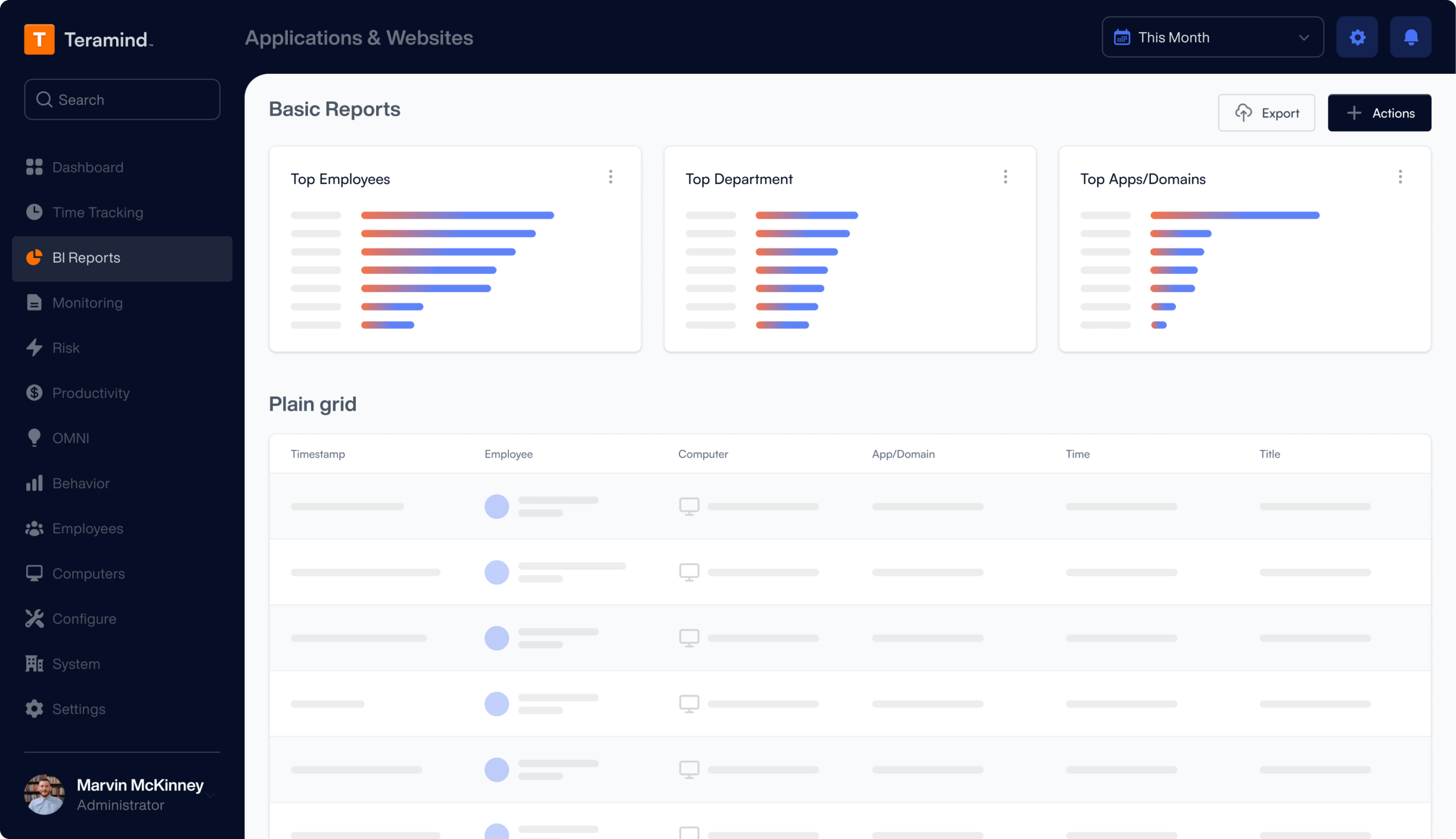
What our Customers Say
“The interface and reporting capabilities of Teramind remain unmatched compared to other products we have tried. Overall, Teramind is far more advanced than other competitors. They are definitely raising the bar and I’ll back them up any day.”
Ricky H.
Government Administration
“It’s been an amazing experience and a wonderful software that does exactly what you want! Security, control, peace of mind, the ability to know all that is going on in the organization. Very easy to use. It gives you real data! It has given us the protection that we need!”
Rene H.
Head IT Security
“This software has allowed us to save from a potential data breach and being able to catch people leaving who tried to take our IP. Very good software. A bit on the expensive side but worth every penny. Functionality is easy to get around. Has a great GUI.”
Milena L.
IT Manager

Got questions? We've got you
What is Office 365 monitoring?
Office 365 monitoring involves the use of tools and solutions to track and analyze the performance, security, and usage of Microsoft Office 365 services. This includes monitoring applications like Microsoft Teams, Exchange Online, and SharePoint Online for potential issues, ensuring data security, and providing real-time alerts on service health. By leveraging advanced monitoring solutions, organizations can gain insights into user activity, optimize resource allocation, and maintain compliance, all while enhancing productivity and ensuring a seamless end user experience.
Does Office 365 monitor user activity?
Yes, Office 365 does monitor user activity to some extent. Admins can access a range of reports and insights through the Microsoft 365 admin center, which provides visibility into user actions such as login attempts, document sharing, and application usage. This monitoring is essential for maintaining security, ensuring compliance, and optimizing resource allocation. However, it's important to note that this monitoring is designed to respect user privacy and is typically used to identify potential security threats, troubleshoot issues, and improve overall service performance.
What can Office 365 admins see?
Office 365 admins have access to a variety of insights and reports that provide visibility into user activities within the Microsoft 365 environment. They can see login attempts, document sharing activities, application usage patterns, and more through the Microsoft 365 admin center. This access is crucial for maintaining security, ensuring compliance, and optimizing resource allocation. However, it's important to note that this monitoring is designed to respect user privacy and is used primarily to identify potential security threats, troubleshoot issues, and enhance service performance.
The Complete Guide to Microsoft Office 365 Monitoring: Balancing Security, Productivity, and Privacy
The modern workplace has undergone a dramatic transformation, with Microsoft 365 (formerly Microsft Office) and cloud services becoming the cornerstone of business operations. As organizations adapt to hybrid work models, the need for effective monitoring solutions for Microsoft Office has never been more critical. However, this necessity brings with it a complex challenge: how to maintain security and productivity without compromising employee privacy and trust.
The Evolution of Workplace Monitoring
From Surveillance to Intelligence
Traditional monitoring approaches often relied on strict oversight and rigid rules, creating an atmosphere of surveillance that damaged employee morale and trust. Modern solutions have evolved beyond simple tracking to incorporate behavioral analysis and contextual awareness, fundamentally changing how organizations approach workplace monitoring.
The Impact of Remote Work
The shift to remote and hybrid work environments has accelerated the need for sophisticated monitoring solutions. Organizations must now balance the need for visibility into their digital workspace with the preservation of employee privacy, particularly when work occurs outside traditional office boundaries. Network monitoring is crucial in these remote work environments to ensure comprehensive visibility into digital workspaces, including cloud services like Office 365.
The Power of Pattern Recognition
Behavioral analytics represents a revolutionary approach to workplace monitoring. Rather than focusing on individual actions, this methodology examines patterns and trends across the Microsoft 365 environment. This shift allows organizations to identify potential security risks and productivity issues while maintaining employee privacy.
Machine Learning and Adaptive Security
Modern monitoring solutions utilize advanced machine learning algorithms to establish baseline behaviors and identify anomalies. This adaptive approach enables organizations to:
- Detect potential security threats based on behavioral deviations
- Identify productivity bottlenecks through pattern analysis
- Maintain compliance while respecting privacy boundaries
The Four Pillars of Modern M365 Monitoring
1. Intelligent Activity Tracking
Modern monitoring goes beyond simple activity logging. It involves understanding the context of user actions within the Microsoft 365 environment. This contextual awareness allows organizations to differentiate between normal work patterns and potential security risks without invasive oversight. Additionally, real-time alerts play a crucial role in intelligent activity tracking by informing users of performance issues or outages as they occur.
2. Behavioral Data Loss Prevention
Traditional DLP solutions often create friction in workflows due to their rigid, rule-based approach. Behavioral DLP represents a significant evolution in data protection strategy. This approach learns from user behavior to establish normal patterns, enabling more effective protection while reducing false positives and maintaining productivity.
3. Communication Security
The modern workplace relies heavily on digital communication tools. Effective monitoring of Microsoft Teams and Outlook requires a delicate balance between security and privacy. Modern solutions focus on communication patterns and behavioral indicators rather than content inspection, ensuring security while maintaining confidentiality.
4. Productivity Intelligence
Understanding productivity in the digital workplace requires more than simple activity metrics. Modern monitoring solutions analyze patterns of work to provide meaningful insights without compromising employee privacy. Identifying and resolving performance issues is crucial to maintaining optimal productivity and ensuring that business operations run smoothly.
Implementing Privacy-First Monitoring
Strategic Planning
Successful implementation begins with careful planning. Organizations must:
- Define clear objectives for their monitoring program
- Identify key stakeholders and their requirements
- Establish privacy guidelines and boundaries
- Develop a communication strategy
Technical Considerations
Cloud Services Platform Integration
Modern monitoring solutions must seamlessly integrate with Microsoft 365 while maintaining security and performance. This integration should:
- Support real-time monitoring capabilities
- Maintain system performance
- Ensure data security and compliance
- Utilize the Microsoft 365 Admin Center for managing users, viewing service health information, and leveraging dashboards for monitoring various Microsoft services. The admin center enhances observability and minimizes downtime through real-time data and alerts.
Scalability and Flexibility
As organizations grow and evolve, their monitoring needs change. Implementation should consider:
- Future growth requirements
- Changing compliance needs
- Evolving security threats
Best Practices for Ongoing Management
Policy Development and Maintenance
Effective monitoring requires clear, well-maintained policies that balance security needs with privacy concerns. Organizations should regularly review and update these policies to reflect:
- Changes in regulatory requirements
- Evolving security threats
- Feedback from stakeholders
- The importance of monitoring service health to ensure visibility into both Microsoft’s infrastructure and the organization’s own dependencies, enabling proactive identification and resolution of any issues impacting service availability
Employee Communication and Training
Success depends heavily on employee understanding and acceptance. Organizations should:
- Maintain transparent communication about monitoring practices
- Provide regular training on security awareness
- Encourage feedback and address concerns promptly
Measuring Success and ROI
Key Performance Indicators
Organizations should establish clear metrics to evaluate their monitoring program’s effectiveness:
- Security incident reduction
- Compliance violation prevention
- Productivity improvements
- Employee satisfaction levels
- Utilizing a service health dashboard to track incidents and advisories affecting Microsoft 365 services, such as Microsoft Teams and Exchange Online. This dashboard provides insights into both Microsoft-owned infrastructure and third-party dependencies.
Continuous Improvement
Regular evaluation and adjustment of monitoring practices ensures long-term success:
- Gather feedback from all stakeholders
- Analyze monitoring effectiveness
- Adjust policies and procedures as needed
Conclusion
Effective Microsoft 365 monitoring in today’s workplace requires a sophisticated approach that balances security, productivity, and privacy. By adopting modern solutions that emphasize behavioral analysis and contextual awareness, organizations can maintain necessary oversight while fostering a culture of trust and respect.
Teramind’s approach to Microsoft 365 monitoring exemplifies this modern paradigm, offering comprehensive visibility while preserving employee privacy through advanced behavioral analytics and intelligent monitoring capabilities. Additionally, monitoring SharePoint Online is crucial for ensuring business continuity and effective knowledge sharing, especially for organizations that depend on it for critical operations. As the digital workplace continues to evolve, organizations that embrace this balanced approach will be best positioned to protect their assets while maintaining employee trust and satisfaction.

